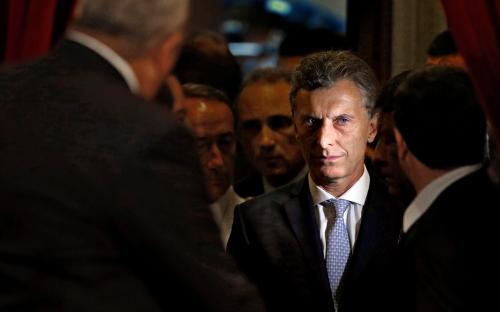This blog post summarizes the findings of the paper, “Macri’s macro: The meandering road to stability and growth,” written by Federico Sturzenegger, who served as Governor of the Central Bank of Argentina from December 2015 until June 2018. This paper is part of the Fall 2019 edition of the Brookings Papers on Economic Activity. Read summaries of all six papers from the journal here.
Mauricio Macri’s election in 2015 sent shock waves around the world. A pro-market outsider candidate from Argentina’s business elites interrupted 14 consecutive years of Peronist government. Macri tapped into the public’s fatigue with his predecessor and ran on “normalizing” the country. During his campaign, he promised to achieve a zero poverty rate, tame inflation, crack down on corruption, and to rekindle Argentina’s stagnant economy. His team shared his enthusiasm and expected that during his first term GDP would grow by 3% per year, inflation would go down to 5% by 2019, and investment would boom. As a result, they believed the specter of left-wing populism would be defeated.
Unfortunately, as shown in figure 1, these expectations failed to materialize. By the end of Macri’s term GDP had shrunk by 3.4%, inflation totaled 240%, and poverty increased. Growing dissatisfaction with the economy led to a devastating election in which Macri lagged 16 points behind the Peronist ticket. In “Macri’s macro: The meandering road to stability and growth,” Federico Sturzenegger sheds light on what went wrong by narrating how fiscal and monetary policy clashed during Macri’s term.

Sturzenegger argues that Macri’s emphasis on gradualism was a double-edged sword. Despite the credit risks it entailed, financing the deficit while pursuing other reforms was viewed as possible at first due to low debt. However, the primary motivation for this strategy was political: to build support for economic adjustments, Macri’s team believed it was necessary to avoid the stigma of being perceived as a conventional right-wing candidate in order to build support for severe economic adjustments. Despite its initial success, political support wavered once its economic risks materialized.
After describing the initial conditions of the economy when Macri took office, Sturzenegger offers a chronological account of Macri’s economic policies. Currency controls were lifted to transition towards a floating exchange-rate regime, and after a devaluation, the peso stabilized quickly. Subsequently, the government reached a settlement with creditors who had refused Argentina’s debt restructuring deals from its 2001 default. By doing so, Argentina regained access to international markets, and the central bank was able to accumulate reserves.
As of March 2016, the central bank sought to engineer a disinflation process through inflation targeting (IT). While critics claimed that its targets were unrealistic since inflation was already high, Sturzenegger shows that many countries have successfully pursued IT starting at similar rates. Indeed, disinflation under IT was successful. Inflation, which had hovered between 25% and 40% for almost a decade, quickly fell below this range. By the end of 2017, core inflation was running at 17% and expectations for 2018 were 14.5%. Yet the program was abruptly interrupted in 2018.
On the fiscal front, energy and transportation subsidies were slashed. During the first four months of 2016, electricity prices increased by 250%, natural gas by 195%, water distribution by 300%, and transportation by 100%. Despite these adjustments, the fiscal deficit increased in 2016. In part, this was due to revenue losses from cutting income, corporate, and export taxes. Since the fiscal account did not improve much in 2017 either, and output growth was significantly below the government’s projections, the central bank’s disinflation program met fierce resistance from the treasury. Specifically, disinflation exacerbated the challenges the fiscal account was already facing given that half of the government’s spending was backward-indexed.
Following a favorable midterm electoral result for Macri’s coalition in 2017, the government became overconfident and reversed course on key policies. In December of 2017, the government announced an increase in the inflation target and lower interest rates, contradicting the central bank’s program. A permanent loss of credibility ensued as the undermining of central bank independence was interpreted as an institutional shift. The concurrence of this event with hikes in U.S. interest rates and a severe drought led to a sudden stop in 2018. The peso depreciated rapidly, inflation expectations increased, and a deanchoring process unraveled.
Desperate for relief, Macri turned to the IMF for assistance. Showing support for Macri’s government, it issued what amounted to a $57 billion loan, the largest in its history. In return, Macri promised to tighten fiscal and monetary policy further and to enshrine central bank independence. Therefore, export taxes were re-introduced, public investment was reduced, and the stabilization fund was drawn-down. However, these measures were not sufficient to contain Macri’s eroding political support, and the public rebuffed his administration in the primary elections. Fearful of the Peronist front-runner, markets panicked and the peso lost roughly half its value, compounding inflationary pressures. The author concludes that the divergence between expectations and reality was mostly due to the government’s fiscal policy and that the experience serves as a reminder of the importance of central bank independence.
The Brookings Institution is committed to quality, independence, and impact.
We are supported by a diverse array of funders. In line with our values and policies, each Brookings publication represents the sole views of its author(s).





Commentary
Lessons learned from the Argentine economy under Macri
September 5, 2019